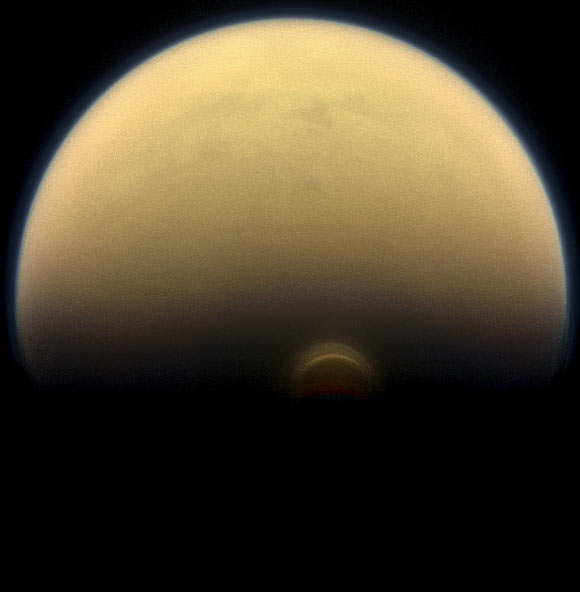NASA’s Cassini spacecraft has detected a giant new ice cloud in low- to mid-stratosphere of Titan, the largest moon of Saturn.

In 2012 Cassini spotted a cloud system called the south polar vortex in Titan’s atmosphere at an altitude of about 186 miles. The spacecraft’s instrument has now detected a massive ice cloud below it. This image was taken by Cassini in 2013. Image credit: NASA / JPL-Caltech / Space Science Institute.
Cassini had already imaged an impressive cloud hovering over Titan’s south pole at an altitude of about 186 miles (300 km).
“During southern autumn when sunlight was still available, Cassini’s Imaging Science Subsystem discovered a cloud around 186 miles near Titan’s south pole. The cloud was later determined by Cassini’s Visible and InfraRed Mapping Spectrometer to contain HCN ice,” said Dr Carrie Anderson of NASA’s Goddard Space Flight Center.
However, that cloud, first seen in 2012, turned out to be just the tip of the iceberg. A much more massive cloud system has now been found lower in Titan’s stratosphere, peaking at an altitude of about 124 miles (200 km).
“That cloud has proven to be only the tip of an extensive ice cloud system contained in Titan’s south polar stratosphere, as seen through the night-vision goggles of Cassini’s Composite InfraRed Spectrometer (CIRS),” Dr Anderson said.
The new cloud system has a low density, similar to Earth’s fog but likely flat on top.
“When we looked at the infrared data, this ice cloud stood out like nothing we’ve ever seen before. It practically smacked us in the face,” Dr Anderson said.
“As the Sun sets and the gloom of southern winter approaches, evidence is beginning to accumulate from CIRS far-IR spectra that a massive system of nitrile ice clouds is developing in Titan’s south polar stratosphere. Even during the depths of northern winter, nothing like the strength of this southern system was evident in corresponding north polar regions.”
“From the long slant paths that are available from limb-viewing CIRS far-IR spectra, we have the first definitive detection of the ν6 band of cyanoacetylene (HC3N) ice in Titan’s south polar stratosphere. In addition, we also see a strong blend of nitrile ice lattice vibration features.”
The size, altitude and composition of the polar ice clouds help planetary scientists understand the nature and severity of Titan’s winter.
From the ice cloud seen earlier by Cassini, they determined that temperatures at the south pole must get down to at least minus 238 degrees Fahrenheit (minus 150 degrees Celsius). The new cloud was found in the lower stratosphere, where temperatures are even colder.
Dr Anderson and her colleagues reported their results today at the 47th Annual Division for Planetary Sciences Meeting in National Harbor, Maryland.
_____
Carrie Anderson et al. 2015. Monstrous Ice Cloud System in Titan’s Present South Polar Stratosphere. 47th Annual Division for Planetary Sciences Meeting. Abstract # 300.01







